-
Cavaliero Finn first spotted the work of Björk Haraldsdóttir in 2017, being instantly attracted to its strong sculptural forms and geometric patterns.
Since then the gallery has featured Björk’s work in several of its shows and she has gone on to win two consecutive Marshwood Arts Awards (2017 Applied Arts Prize, selected by John Makepeace OBE & 2019 for the John Hubbard Prize). In 2018, her work was selected for the Royal Academy Summer Exhibition by Grayson Perry.
Cavaliero Finn will be showing a selection of new work by Björk Haraldsdóttir alongside textiles by Jacy Wall at stand G45 at Platform – Threading Forms curated by Candida Stevens, a satellite exhibition which focuses on artists working with textiles. The London Art Fair is on from January 22nd – 26th 2020.
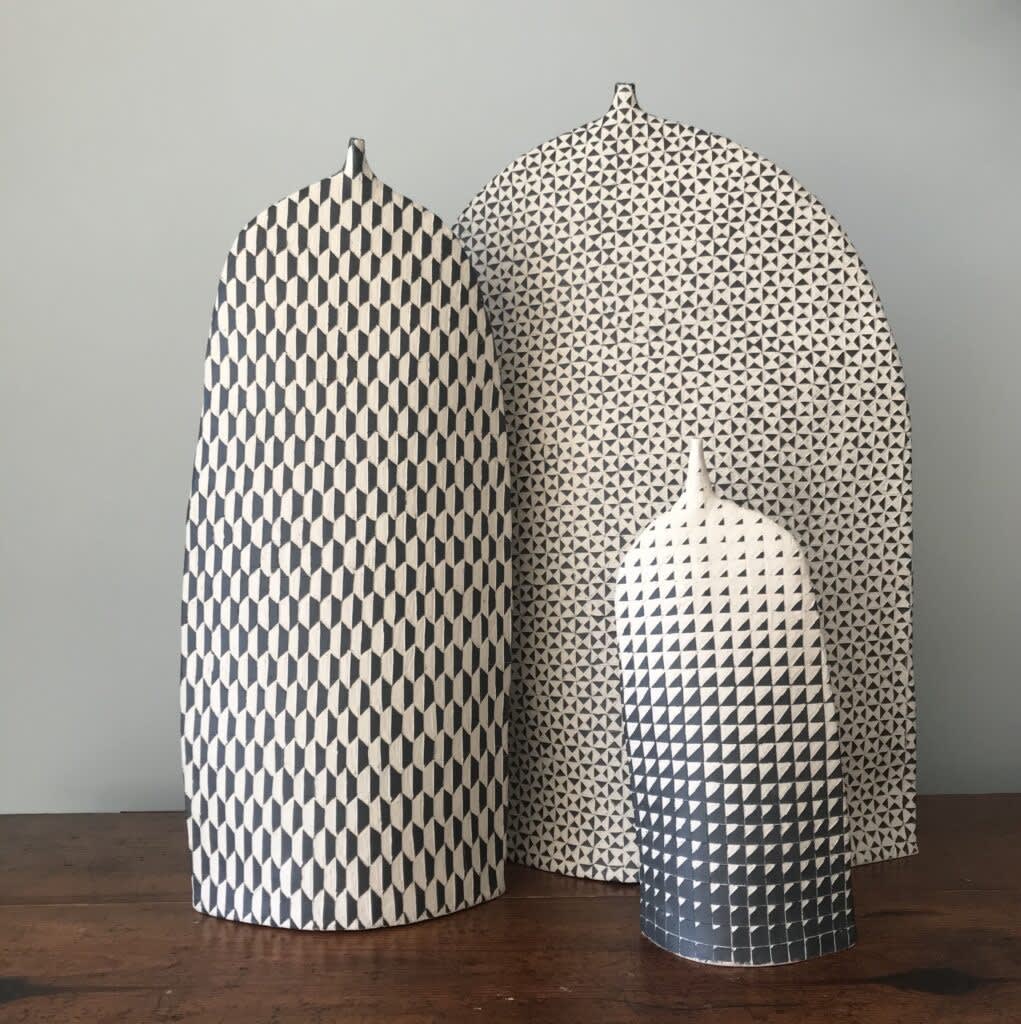
New work by Björk Haraldsdóttir for the London Art Fair – left to right:
Basalt II- stoneware, black slip, 57 (H)x 33 cm (W) 2020
Poem – stoneware, black slip, 58 (H) x 41 cm (W) 2020
Horizon III – stoneware, black slip, 31 (H) x 15 cm (W) 2020CF: We chose your work to accompany Jacy’s textiles at the London Art Fair because we can see the importance of pattern and textiles in your work, can you tell us more about this?
BH: When I started on the particular process that defines this work I wasn’t conscious of any strong connection to textile but that understanding has grown. At the core of this work is a conversation between 3-dimensional form and 2-dimensional pattern. The pattern is draped across the form and changes the perception of the shape.
I started my ‘pattern journey’ referencing to old textile work and stitching patterns from Iceland and the Nordic Culture. This has developed over time into patterns inspired by ideas and images I come across in nature and daily life. I am constantly working into the pieces ‘making stitches’ or lines of weave and the result is often cloth-like in appearance. The ceramics are mostly built in stoneware clay and painted with slip which is then scraped back to reveal the base material in two-tone monochrome patterns. The scrape marks are visible and the surface is a plane of shallow relief, much like a tapestry. The tactile nature of these pieces is important -they are an invitation to touch, much like one would like to handle a draped cloth.

New work by Björk Haraldsdóttir for the London Art Fair
Tapestry #66.1 , stoneware, black slip and red rlaze , 52 (H) x 33 (W) cmCF: You originally trained and worked as an Architect. What brought you to focus on ceramics? And how does that training influence your work?
BH: Architecture is a complex and rewarding creative endeavour but is it constrained by a vast array of technical and legislative issues. Producing un-commissioned artwork strips away the burden of those constraints to leave only the creative act, a liberating situation and an issue that I am not complacent about. My work, however, remains unequivocally architectural to my eyes and is influenced by my training and profession in many ways. I still plan and draw works before they are made like an Architect and ‘feel’ and adapt the work as it is made like an artist.
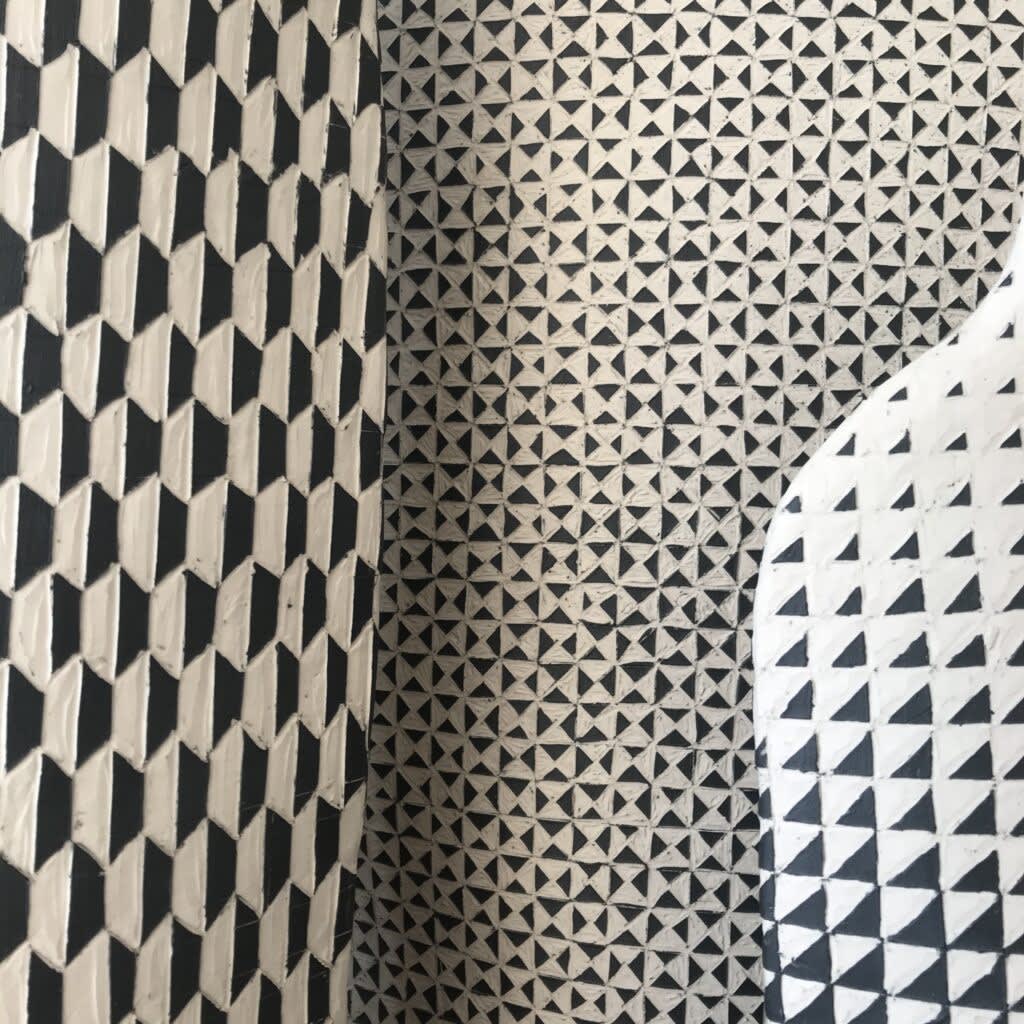
Monochrome medley – detail of just some of the new work we have by Björk Haraldsdóttir for the London Art Fair
CF: Your palette is muted and monochrome is this a conscious decision?
BH: I have always been drawn to monochrome and I suppose it could be seen as a reflection of the monochromatic palette of the Icelandic landscape, particularly in winter. I often think my work is evocative of that landscape with black lava peeking out from beneath snow-covered planes but that is certainly not the intent of the work. The process suits monochrome but the limited palette seems to strike the right balance between form and pattern. Adding another dimension (colour) would, I think, subtract from the effect rather than add to it. I have produced some work with third colour highlights which is sometimes effective in drawing the eye and setting up another narrative. For example, I often line internal surfaces at openings such as the neck of bottle shapes, which begin to suggest a hidden organic interior.
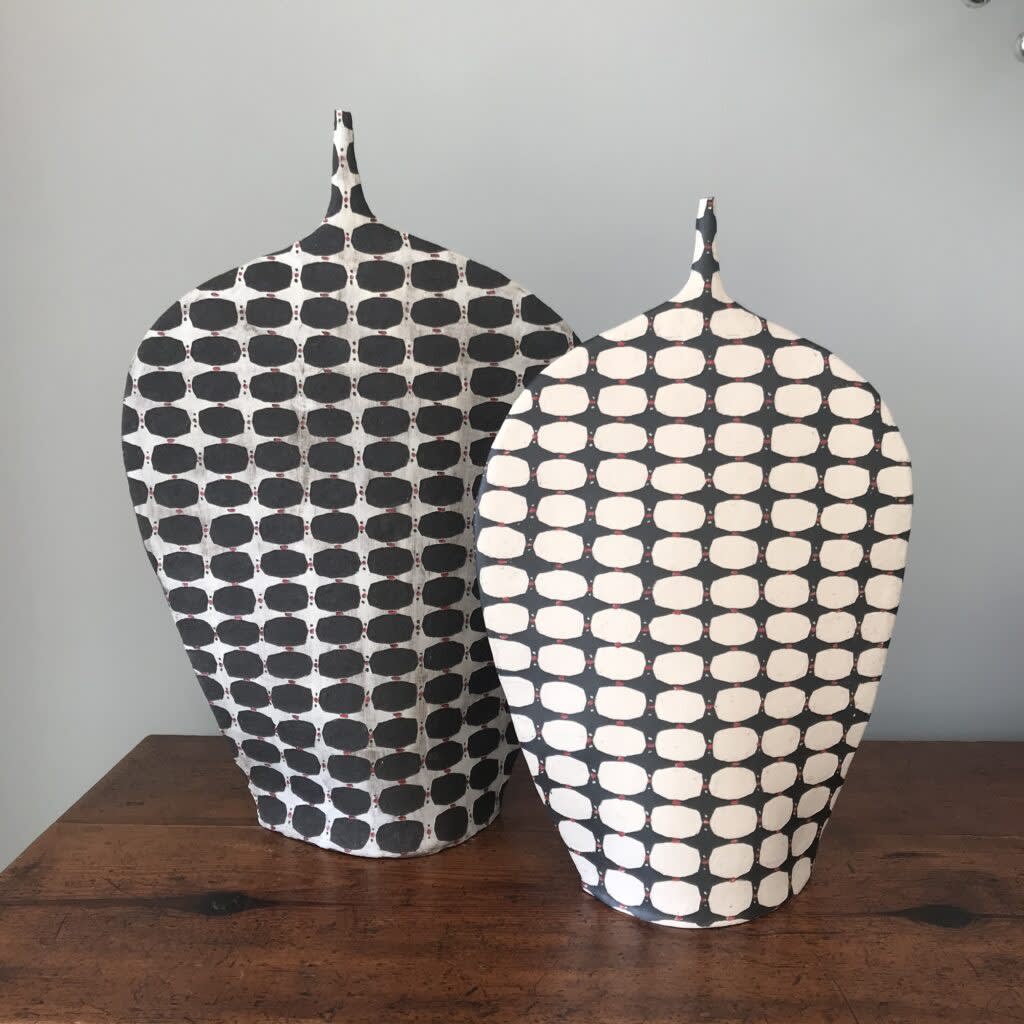
New work by Björk Haraldsdóttir for the London Art Fair – left to right
Tapestry #66 – black stoneware, white slip and red glaze 60 (H) x 40 (W) cm, 2019
Tapestry #66.1 – stoneware, black slip and red glaze 52 (H) x 33 (W) cm, 2019CF: Form and surface are both integral to your work, what do you think of first?
BH: Form and pattern are individually and equally important but this work is defined by the interaction of these very distinct attributes. There is often an ambiguity in the pieces caused by the drape of the pattern over the form, which begins to disguise the shape as it runs seamlessly across creases and corners. Shape and pattern are usually conceived in a planned design however I have become more flexible over time and now often build the form and assess it before committing to the pattern. I like to place a rigid, geometric pattern onto an organic form – a bottle or bell shape. The ‘grain’ of the pattern vastly alters the perception of a piece and two superficially similar forms will appear unrelated when rendered with different patterns.
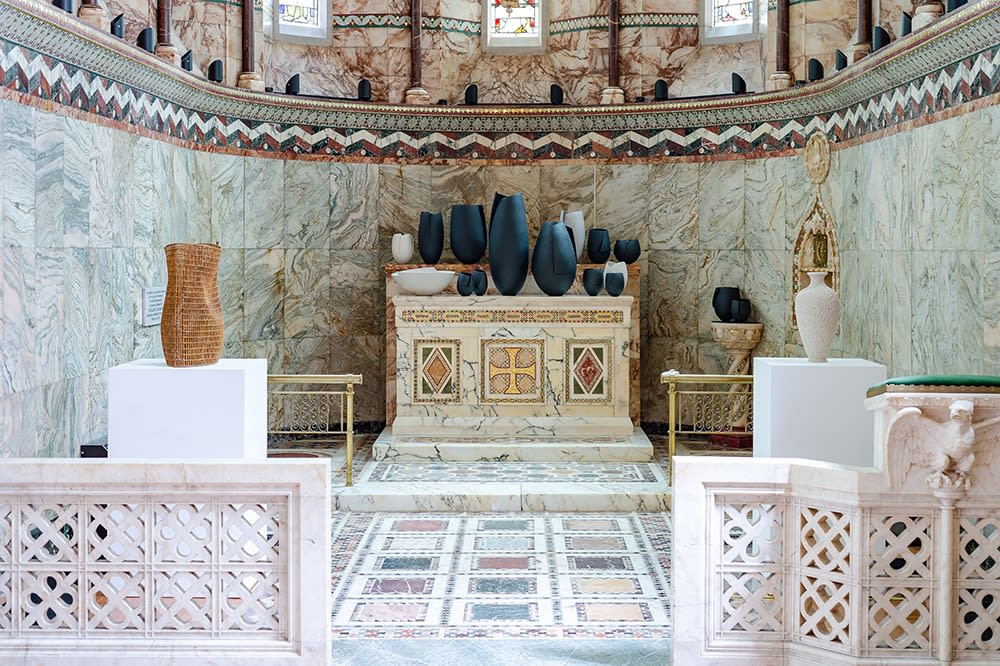
Net by Annie Turner and Cut and Altered Vessels by Ashraf Hanna seen at Cavaliero Finn’s recent show Alter at Fitzrovia Chapel
CF: Which contemporary ceramic artists inspire you?
BF: There are of course so many but in terms of modern makers, I love Annie Turner’s work and would love to see her process. People like Ashraf Hanna, Patricia Shone and of course Akiko Hirai are all making magic and the list goes on.
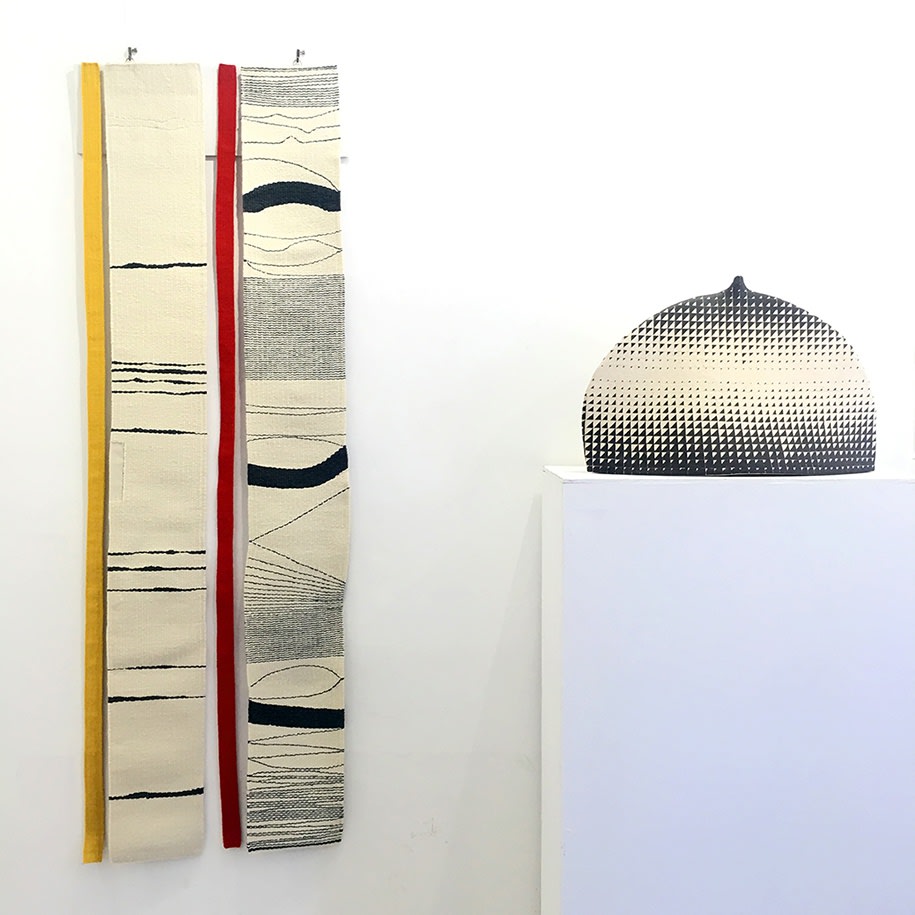
Fine lines tapestry by Jacy Wall sits alongside
Ebb by Björk Haraldsdóttir – stoneware, black slip, h 35 x w 52 cm, 2019
CF: You have shown with Jacy Wall in the past, why do you think your work sits so well together?
BF: We first exhibited together a couple of years ago in a self-curated group show in Bridport. Our work particularly seemed to gravitate towards each other’s and at the end of set-up, most of our work sat together in reciprocal arrangements. I think there is an obvious visual connection in the monochrome works but there is also an intricate textural relationship which derives from the processes we apply to our work. I also happen to adore Jacy’s work!
